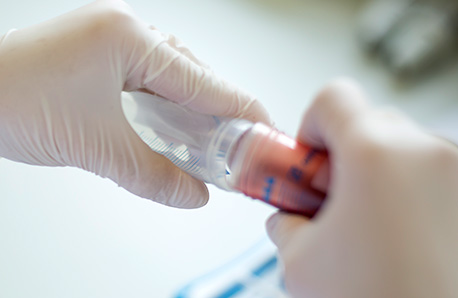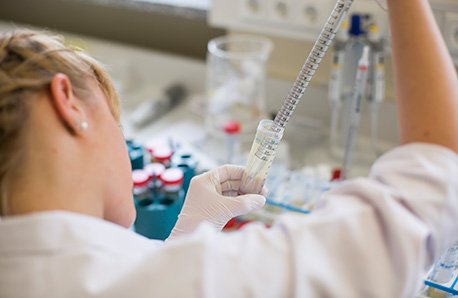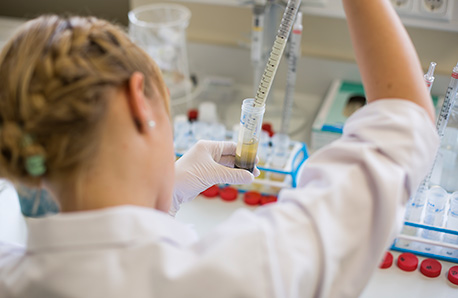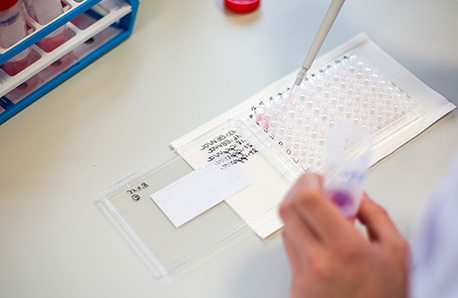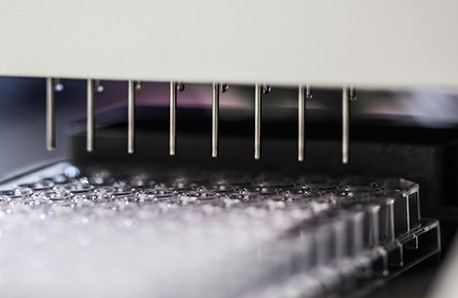EliSpot
Borrelia infections do not only show humoral immune responses by antibodies, but can activate T-lymphocytes at the same time. Once Borrelia burgdorferi is not active anymore, the T-cellular immune response should vanish.
It is not possible to control the treatment success by Borrelia antibodies because the “titer” of antibodies can persist in the blood over years. Recent Borrelia burgdorferi infections (e.g. ‘bull’s-eye rash’ or ‘summer flu’) develop antibodies after weeks and sometimes even do not show them at all.
The Borrelia EliSpot can eliminate some problems:
- The test reflects the current Borrelia burgdorferi activity of chronic and recent Borrelia burgdorferi infections.
- The EliSpot is highly sensitive and can detect even one single Borrelia burgdorferi-reactive T-cell. With detection levels that can be as low as one cell in 100.000, the EliSpot is one of the most sensitive cellular assays available.
- The EliSpot is between 20 and 200 times more sensitive than a conventional ELISA.
- The EliSpot displays a similar sensitivity as a RT-PCR (Real Time PCR) analysis, but detects the secreted protein instead of the mRNA (messanger RNA).
- The EliSpot can be helpful when monitoring therapies. The EliSpot should usually become negative about 4 to 8 weeks after the completion of an effective therapy.
Major Article in the Clinical Infectious Diseases Journal
Scientific Paper concerning the Detection of IFN-γ Secretion by T Cells collected before and after successful treatment of Early Lyme Disease.
Positive reactions in the EliSpot demonstrate current active infections against:
- Borrelia burgdorferi
- Borrelia miyamotoi
- Anaplasma / Ehrlichia
- Bartonella henselae
- Babesia microti
- Chlamydia pneumoniae
- Chlamydia trachomatis
- Mycoplasma pneumoniae
- Yersinia
- Epstein Barr Virus (EBV)
- Herpes Simplex Virus (HSV 1/2)
- Cytomegalovirus (CMV)
- Varizella Zoster Virus (VZV)
- Candida albicans
- Aspergillus Peptide Mix 1 & 2
Dr. Leo Joosten, Department of Medicine , Radboud University, Netherlands:
Q: What solutions that are currently being pursued do you believe hold the most promise for diagnosing Lyme disease at a high confidence level? Which tests currently available to the general public, other than the western blot test, do you believe provide a better degree of certainty?
A: “At the moment, there are cellular based tests on the market. LTT and EliSpot are a few of these tests. These tests give us information about the cellular immune response towards Borrelia antigens. It seems that these tests will be used in the future, apart from serological tests.”
Borrelia EliSpot (T-Cell-Spot / IGRA: Interferon-Gamma-Release Assay)
Borrelia EliSpot antigens:
- Borrelia burgdorferi Fully Antigen: Borrelia burgdorferi B31-reference strain (Borrelia burgdorferi sensu stricto)
- Borrelia burgorferi Peptide-Mix: OspA from Borrelia b. sensu stricto, Borrelia afzelii, Borrelia garinii + OspC native + DbpA recombinant
- Borrelia burgdorferi LFA-1 (Lymphocyte Function Antigen 1): Own body protein + Borrelia burgdorferi sensu stricto (shared epitope). Often associated with autoimmune diseases: collagenosis, Rheumatoid Arthritis, vasculitis (ANA, CCP-antibodies, ANCA)
Explanation: Native = cultured antigens/ Recombinant: genetic technology produced
Reflecting the current T-cellular activity of Lyme disease:
- Indication for a currently active Borrelia burgdorferi infection in cases of furthermore positive EliSpot after the end of therapies
- T-Cell-Spot/IGRA has been approved by the FDA in May 2011 for M. tuberculosis:
“… A positive result suggests that an infection is likely, a negative result suggests that an infection is unlikely…” “…Results can be available within 24 hours…”
EliSpot: New T-Cell Test a “Game Changer” for Lyme disease:
… The sensitivity of EliSpot is estimated at 84%, and the specificity is 94%…
… EliSpot assays provide robust, highly reproducible data…
… EliSpot can be retested for the acquisition of additional information in follow-up assays…
… the two assays systems (EliSpot + CD57-cell count) compliment each other in the quest to understand T cell-mediated immunity in vivo….
Lehman PV et al.: Unique Strengths of EliSpot for T Cell Diagnostics in: Kalyuzhny AE. Handbook of EliSpot: Methods and Protocols, Methods in Molecular Biology, Vol. 792. 2nd Ed: Springer; 2012: 3-23

